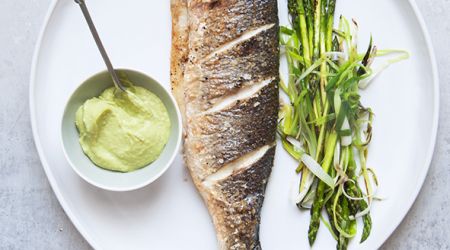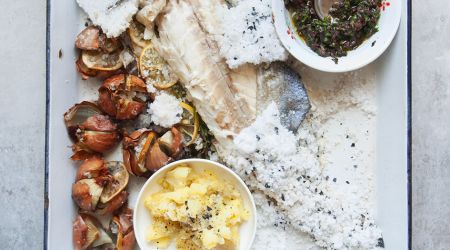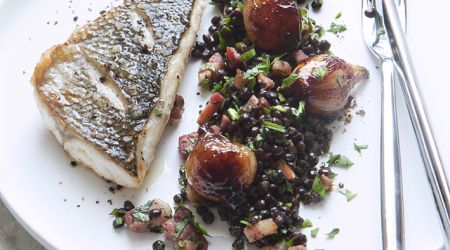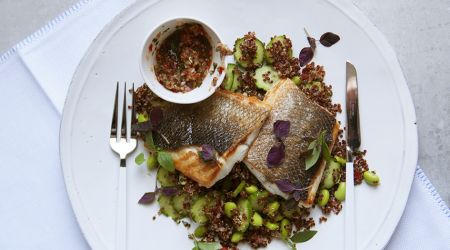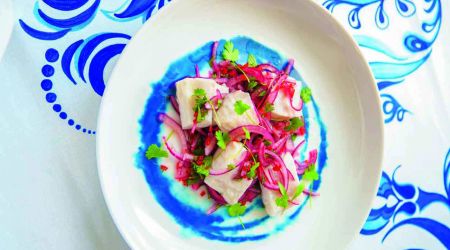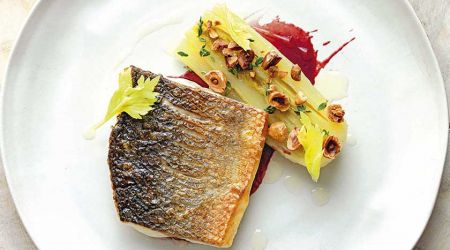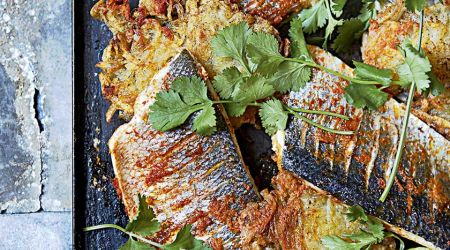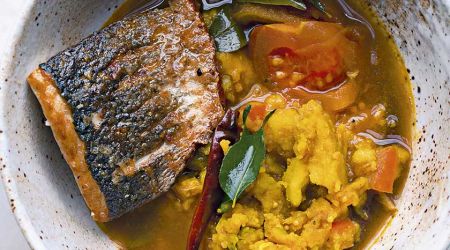Seabass
Since its debut on the UK restaurant scene in the 1980s, sea bass has become a superstar fish, but at what cost, asks Clarissa Hyman?
I am always a little puzzled by the description of Dicentrarchus labrax as sea bass. Not that I insist on ordering my main course in Latin, although it would be a conversational opener (or relationship stopper), but because it is axiomatic. I mean, where else is the fish to come from? The swimming pool? The bathtub? Of course it’s a fish from the sea, as opposed to a freshwater fish, but we don’t go round saying sea cod or sea haddock, do we?
Prized since Roman times, bass has been described as a handsome and voracious fish, which makes me think of it as something of a deep-sea player, a kind of keen-eyed Sean Penn with silvery flanks and chain-mail scales. It’s a favourite with anglers, especially in the south of Ireland, where it is sometimes called ‘bairs’, a word more similar to the Danish ‘bars’ and the Anglo-Saxon ‘baers’ rather than the English ‘bass’. Why that should be, I have no idea. They also used to be called ‘salmon bass’ by fishwives in the west of England because of a superficial similarity in looks, although they are in no way connected with the salmon family. They are found as far south as Senegal, through the Mediterranean and in the East Atlantic up as far as Norway. Their most famous cousin is the American striped bass or ‘striper’ – easily identified by the parallel, go-faster black stripes along the platinum body – which ranges from the Gulf of St Lawrence down to the Gulf of Mexico. It was successfully introduced to the Pacific coast in the 19th century and now is an important sporting game fish. Bass has become a top restaurant favourite as it boasts firm, delicate but well-flavoured flesh, is relatively free of small bones and holds its shape well after cooking. They look particularly fine when presented whole, usually roasted, as they rarely grow longer than 80cm, but they can be cooked in a great variety of ways – steamed, boiled, grilled, fried, poached, stewed or baked. The simplest method, however, as experience regularly teaches us, is often the best. One excellent and mouthwatering way is to bake it Santander style, strewn with a mixture of toasted almonds, toasted breadcrumbs and parsley. Bass pairs particularly well with other Mediterranean flavours: tomatoes, garlic, olive oil and red peppers, as well as oriental flavours, such as fermented black beans, sesame, lemongrass, dark soy and ginger. A whole fish baked in salt is a classic Italian dish; cooking bass en papillote with aromatic flavours is also typical. Rather like cod, the cheeks of bass are sweet and lightly flavoured, and are considered a delicacy. The skin too, when crispy, is excellent eating. They are said to be a remarkably intelligent fish in so far as they seem to be able to spot a fishing boat when conditions are clear and scarper as fast as they can. Conversely rough seas and poor visibility for the fish mean a better catch. Their popularity, however, has led to overfishing of wild stocks: their vulnerability has been increased by a toxic combination of illegal fishing, slow growth, late maturity, spawning aggregation and strong summer- site preference leading to exploitation and localised depletion in certain areas.
In 2017, the Marine Conservation Society (MCS) announced the spawning biomass for the stock around the British and Irish coasts were at their lowest observed level and scientists from the International Council for the Exploration of the Sea (ICES) advised there should be zero catch (commercial and recreational). Various fisheries in the Northeast Atlantic such as that in the Bristol Channel, and even the Dutch rod and line fishery, have had their Marine Stewardship Council (MSC) certification withdrawn. In some parts of the world, landed fish must be a minimum size; in others there is a closed season, particularly for recreational fishing, but reliable data remains hard to come by and sustainability levels are unclear.
However, the ability of bass to live in saltwater or brackish lagoons make the species suitable for farming. There are fish farms around the Mediterranean, especially in France, Spain and Italy, but Greece and Turkey are the biggest producers. While their sustainability ratings are much higher than wild, according to the MSC, there is still concern: bass farmed in open-net pens can cause environmental issues including pollution from nutrients and organic matters that lead to environmental changes; escaped farmed fish; use of chemicals in production; interaction with local wildlife including lethal predator control and some concerns regarding regulatory controls. Bass are carnivorous and require more fish in their diet than they actually produce, leading to a net loss of marine proteins and oils but, problematically, the fish used to make their food cannot be assured of having been sourced from a sustainable supply.
As to difference in taste, farmed fish have a good savoury flavour with a slight oiliness from the fat deposits created by the feeding process and more relaxed lifestyle; wild fish, by their predatory nature, are leaner and more meaty. It is not always easy, however, to differentiate farmed from wild purely by looks: the late fish expert William Black noted that if you happen to see a shop with a whole load of bass of almost identical size including some with snubby noses, then they are almost certainly farmed.
The moral, of course, is not necessarily
to avoid bass altogether but to purchase
with the knowledge that it is sourced from
a responsible fish farm – and to treat it with
due respect as you cook and eat it.
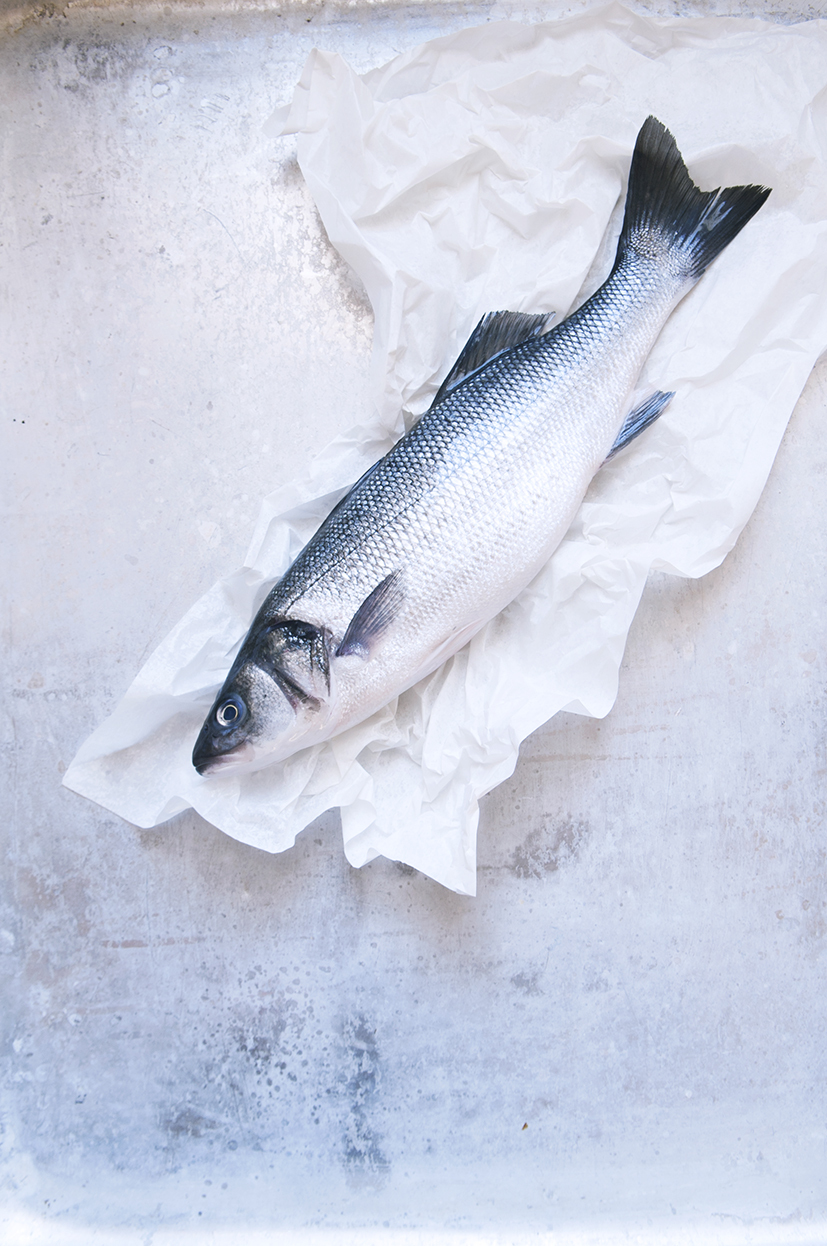
Recipes
Get Premium access to all the latest content online
Subscribe and view full print editions online... Subscribe

